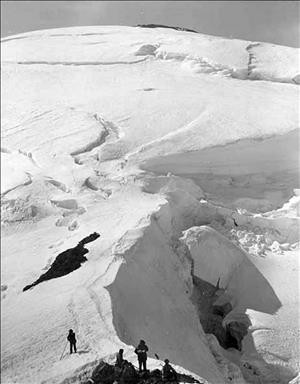On July 28, 1896, Tacoma's Olof Olsson Bull (1852-1933) scales Mount Rainier and plays on his fiddle several solo songs -- including "Nearer, My God, To Thee" -- at the Columbia Crest summit. That feat will be credited in a 1962 mountaineering history book as "a remarkable solo climb," which almost made further history as Rainier's first such; however another hiker, a Mr. A. B. Wood, suddenly passed Bull on the trail mid-route (Haines). Undaunted, Bull forged upward and his brief high-altitude (14,000+ feet above sea level) concert was that day's capper.
Divine Music
In 1890 Professor Olof Bull arrived in Tacoma. He'd been born in Undersvik, Hälsingland, Sweden, on March 31, 1852, to parents Olof and Katarina Bull. As one history put it:
"From early childhood he evinced extraordinary talent for music which was cultivated to a marked degree under A. Sorenson and other masters. In 1869 he sailed for America, arriving in St. Paul [Minnesota], where he rapidly gained fame as a genius violinist. In 1876 he organized the 'Olof Bull Concert Company' which scattered divine music the land over, and rose to enviable reputation. In 1881 he was appointed musical director of the Boston Opera, which he resigned in a year to accept the professorship of violin in the Chicago Musical College, where he remained until 1890" (Stine).
Upon his arrival out West, Professor Bull worked as a violin teacher and as musical director of the orchestra at the Tacoma Theatre (S 9th Street & SW corner of C Street [today’s Broadway]) -- a "chair he is filling with distinction. Professor Olof Bull is a genius as a violinist, and greater still a man of character, kind and compassionate" (Stine). Bull's students were known in Tacoma for giving recitals of classics by composers such as Beethoven, Tchaikovsky, Musin, and Handel, which were appreciated by the entertainment-starved locals.
Moonlight Musicales on the Mount
While living in Tacoma, Bull became -- like so many of his townsfolk -- thoroughly enchanted by the 14,000-ft mountain that dominated their eastward skyline. Thus, as an energetic and fit man, he was among those who made early efforts to mount expeditions to surmount it.
In August 1892 Professor Bull climbed his way up to Paradise Park -- a base camp from where he intended to make the ascent (with his violin), but he failed in that goal. It is known, however, that he did succeed in entertaining "some excursionists encamped there with some charming moonlight musicales" (Haines, p. 138).
A Violin's Violent Demise
The next year saw Bull return with a six-man party:
"He again set out for the mountain in the expectation of ascending it with his violin to give a concert upon the summit, but his luck was not with him. As a prelude to his misfortune, the violinist fell into the Nisqually River while fetching water for the camp on the second day; then, soon after starting the following morning, his violin fell from the wagon, which ran over instrument and case. But, the smashing of his violin was not the end of Mr. Bull's troubles. He lost control while glissading a slope ... was dashed into some rocks and painfully injured, ending his mountain climbing for the season, with a ride on an improvised rescue toboggan" (Haines, pp. 164-165).
Bull's fascination with Rainier remained strong: One vintage photograph, probably from 1893, shows him and his climbing party near the top.
In 1896 he finally hauled his violin up to the summit and there he played it.
Bull made it to the top again in 1898. On this occasion he and his climbing party explored for a full two hours before descending to Paradise.
Professional Professor
In 1896 Professor Bull was hired as a violin instructor at Puget Sound University, and in 1899 George F. Whitworth's Sumner Academy -- originally founded in the village of Sumner in 1883, and incorporated as Whitworth College in 1890 -- moved about 10 miles from its original home, westward to Tacoma. There, upon re-opening on January 2, 1900, Bull was among its new faculty members. By 1914 the school had relocated to Spokane, and in 2007 it became Whitworth University.
Olof Bull passed away on April 19, 1933.

